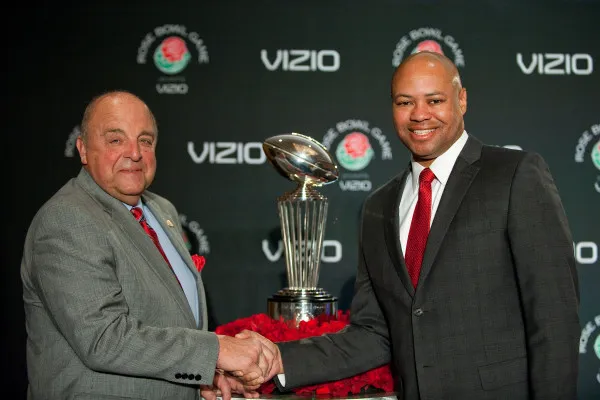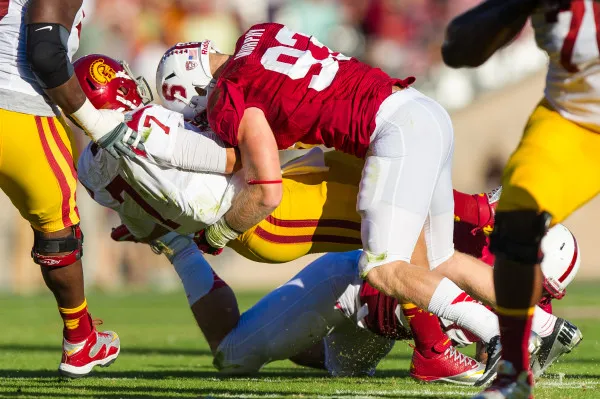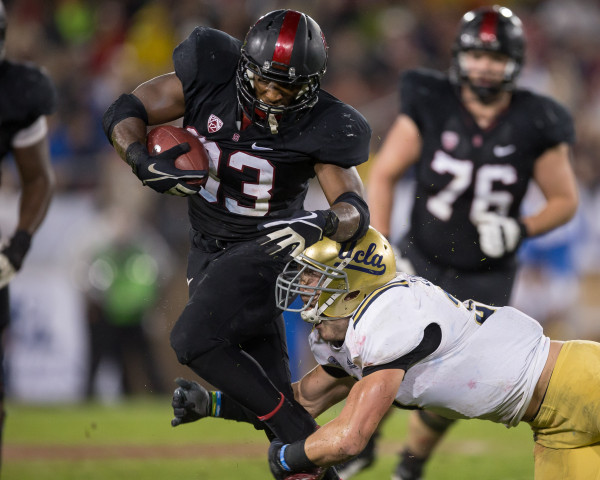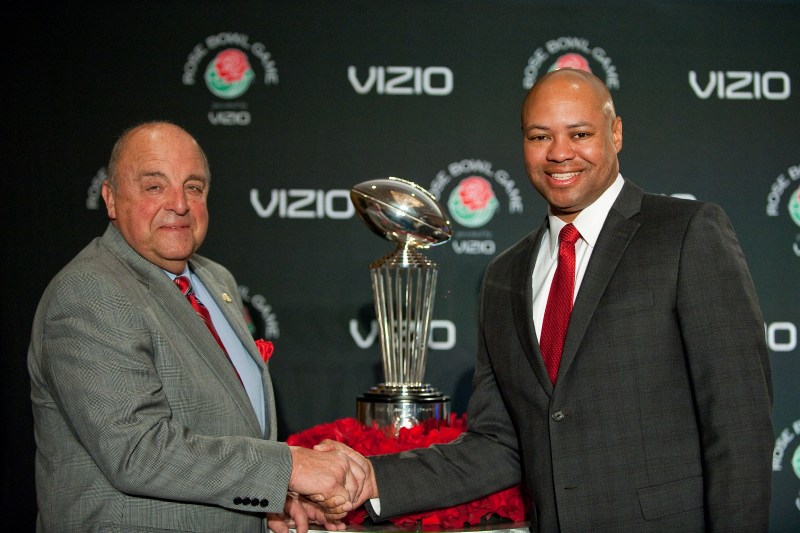The last time Stanford won the Rose Bowl, Richard Nixon was the President of the United States.
The last time Stanford won the Rose Bowl, its school mascot was the Indians.
The last time Stanford won the Rose Bowl, head coach David Shaw hadn’t even been born yet.
It’s been a while since the Cardinal has come out on top in the Granddaddy of Them All — 41 years to be exact. Tomorrow on New Year’s Day, No. 6 Stanford (11-2, 8-1 Pac-12) finally has the chance to end that drought as it squares off against Wisconsin (8-5, 4-4 Big Ten) at the Rose Bowl in Pasadena.

The looming showdown is a rematch of the 2000 Rose Bowl, a game that saw Wisconsin erase a six-point halftime deficit as Heisman-winning running back Ron Dayne lifted the Badgers to a 17-9 victory over the Cardinal. While Stanford hasn’t made a return trip since then, Wisconsin will be playing in its third straight Rose Bowl after losing to TCU and Oregon the past two years.
“[Wisconsin] is a physical group that’s got one goal in mind,” said defensive coordinator Derek Mason. “They’ve been here a couple of times. They want to walk out of here with some hardware. So do we. We didn’t come here to get a t-shirt or a hat. We came here to win.”
***
It was a tough, long road for both teams in 2012.
Defying all pundits who predicted a drop-off for an Andrew Luck-less program, the Cardinal defeated four ranked opponents, including then-No. 2 Oregon, in just as many weeks to close out the year. A gutsy, comeback victory over UCLA in the Pac-12 Championship Game then secured the conference title for Stanford, which is now playing in its third consecutive BCS bowl. The Cardinal owned one of the strongest strengths of schedule this year; its opponents had the most combined FBS wins of any team’s schedule in the nation.
For Wisconsin, its five losses belie the fact the average margin of those defeats — three of which came in overtime — was just 3.8 points. The Badgers took Penn State and undefeated Ohio State to the brink before trampling Nebraska in the Big Ten Championship and punching its ticket to Pasadena. Even the departure of head coach Bret Bielema did not demoralize the team, as highly-respected Wisconsin athletics director Barry Alvarez, affectionately called “The Godfather” by his players, stepped in to temporarily take the reins at head coach.
“We give Wisconsin all the respect in the world,” Shaw said. “The way they’ve run the ball, the way they’ve stopped the run and the way they’ve played on special teams. Watching the film, you earn a lot of respect for these guys.”
In line with the pregame script of strength-on-strength, Stanford’s suffocating run defense faces a stiff test in slowing down the most prolific running back in college football history, Montee Ball. The Doak Walker Award winner is the NCAA record-holder in both rushing and total touchdowns and seeks to end his collegiate career with a Rose Bowl victory after falling just short the last two years.
“Ball has much better speed than people give him credit for,” said defensive end Ben Gardner, who registered 14.5 tackles for loss and 7.5 sacks this season. “But he’s very big, and powerful, and he’s got great balance. He’s able to bounce off blocks and uses his spin move very well…We’ve faced a lot of great backs. But none with the complete and total package of a power back with breakaway speed.”
Although stopping Ball is a major component of the gameplan, the Cardinal is well aware of the Badgers’ other two halfbacks, James White and Melvin Gordon, who complete Wisconsin’s three-headed rushing attack that averages almost 240 yards per game. Shaw drew comparisons between the speedy Gordon, who can change field positions with a single run, and Stanford’s own stable of explosive running backs, Kelsey Young and Anthony Wilkerson.
“You have to be aware of what each guy is capable of and, potentially, how offenses try to use him,” said inside linebacker Shayne Skov, who recorded 12 tackles and three sacks in the 2011 Orange Bowl. “But no matter who is back there, we have to play our defense. That doesn’t change your alignment or your responsibility in the scheme.”

The Cardinal features one of the most feared front sevens in the country, a unit that currently leads the nation in sacks (56) and tackles for loss (120). Though ranked third in rushing defense (87.69 yards per game), Stanford unexpectedly faltered in that area in the Pac-12 title game against UCLA and allowed Doak Walker Award finalist Jonathan Franklin to run rampant for three quarters. The Bruins especially had success implementing jet sweeps that challenged Stanford’s defense on the edge.
For the Cardinal to halt Wisconsin’s creative running game, it starts with position discipline.
“You make sure you’re taking care of your responsibility,” said captain outside linebacker Thomas. “If you’re responsible for the box, you take care of the box. If you’re responsible for the outside, the perimeter runs, you’ve got to make sure you’re there for that.”
Although effective play action usually complements a strong ground game, the passing game has not opened up at all for the Badgers this season. Statistically speaking, Wisconsin was one of the worst passing teams in the country, airing it out for just 162.6 yards per game. Fifth-year senior quarterback Curt Phillips, who was forced to miss the first two years of his career with a knee injury, averaged only nine completions in the four games that he played.
One of Stanford’s most glaring weaknesses last year was the shaky play of its secondary, which was especially harassed by Oklahoma State in the 2011 Fiesta Bowl. But this season, Mason has turned the unit into one of the team’s fortes. Should Phillips dare to throw, free safety Ed Reynolds, who leads the NCAA in interception return yardage (301) and took three of his six picks to the house, will look to reinforce his reputation as one of the country’s most dangerous ball hawks.
“We’re a proud unit,” Gardner said. “Everybody gives credit our front end, but something they don’t understand is we have two of the best run stop and safeties in the nation as well. And our corners will come up and hit you, too. So it’s been a complete effort with 11 guys every week.”
***
On the other side of the ball, Stanford’s offense looks to unlock an all-around solid Wisconsin defense that mirrors the Cardinal with its physical, aggressive style of play. Under the guidance of defensive coordinator Charlie Partridge, the Badgers defense has followed the “bend, but don’t break” motto to a tee, giving up no more than three touchdowns in any regular season game this year.
The consistent and clutch play of quarterback Kevin Hogan galvanized the Cardinal offense in the back half of the season. Hogan certainly does not shy away on the biggest stages; the redshirt freshman threw game-winning touchdowns against Oregon State, Oregon and UCLA. His sudden emergence has warranted a great deal of comparisons between him and a younger version of Andrew Luck in terms of their size, poise and running abilities.
“[Hogan’s] growth has been phenomenal,” Shaw said. “His athletic ability is something you can’t teach. When he gets out in space and makes a guy miss or breaks a tackle, that’s such a plus. It’s something defenses have to account for.”

If Hogan is the brain of the Stanford offense that remains calms in high-pressure situations, then running back Stepfan Taylor is the heart that keeps the offense alive. Despite carrying a heavy workload this season, the senior captain still found way to maintain a high level of efficiency, averaging 4.8 yards per carry and amassing 1,442 rushing yards. The all-time Stanford rushing leader will have his work cut out for him against a stout Badgers defense ranked in the top 20 in both points allowed and run defense.
In addition to being lethal in the screen game, Taylor has opened up huge passing lanes downfield for Hogan when opposing defenses load the box to stop the run. The tight end duo of Levine Toilolo and Zach Ertz, a unanimous All-American, has been the main beneficiary of the play action.
“When we can get into those big-people personnels, we’re able to stay on the field,” Ertz said. “The receivers are usually out of there, and it’s usually two tight ends, an extra linemen and two running backs. So the defense is thinking run, and we spring a pass on them.”
In parallel with Hogan’s evolution under center, the offensive line has also developed a strong, cohesive identity despite losing two All-Americans in David DeCastro and Jonathan Martin from last season. While this year’s sack count (19) was significantly larger than last year’s (11), the trench-men, anchored by captain center Sam Schwartzstein and consensus All-American tackle David Yankey, has given up at most one sack in seven of the twelve games.
“We want to go up and play our game no matter who is across the ball,” Yankey said. “That is the last thing [offensive line coach Mike] Bloomgren leaves us with before every game. Forget what they do, it’s all about what we do; so we’re going to trust our technique.”
The Cardinal roster appears to be at full strength, as the extra month of preparation time has allowed some banged-up players to heal. Among them is Ty Montgomery, the sophomore wideout who has seen limited action since suffering a knee injury in early-October. Montgomery exploded in last year’s Fiesta Bowl, hauling in seven catches for 120 yards and a touchdown.
Punter Daniel Zychlinski, who sat out the Pac-12 Championship Game with a shoulder injury, “feels great” according to Shaw and is expected to start tomorrow.
However, senior nose tackle Terrence Stephens is ineligible to play due to a secondary NCAA violation; in his place, redshirt junior David Parry will make his third straight start.
“It’s big for myself, my teammates and the school,” Taylor said. “To be able to come here and play in the Rose Bowl was a goal we set early on in the season. We’ve got to finish though. You don’t want to just get here and be a participant in it.”
The Rose Bowl is slated for a 2 p.m. kickoff tomorrow, with national television coverage on ESPN.
For previous installments in The Daily’s coverage of the 2013 Rose Bowl:
Rose Bowl: Badgers talk Hogan, tight ends and Cardinal offense
Rose Bowl: Hamilton, Stanford’s offense prepare for physical Badgers defense
Rose Bowl: Cardinal defense readies for Ball, run-heavy Badger attack
